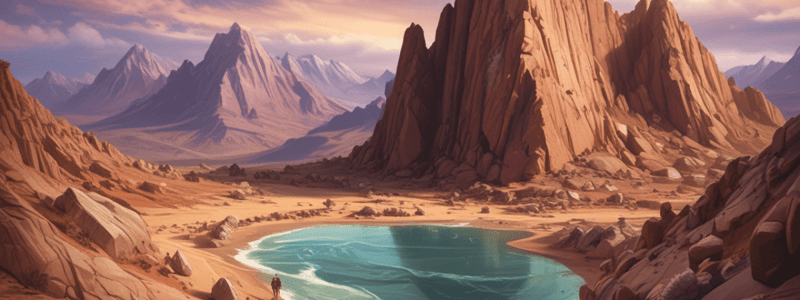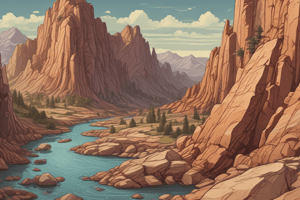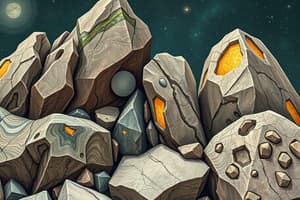Podcast
Questions and Answers
What is a characteristic feature of foliated metamorphic rocks?
What is a characteristic feature of foliated metamorphic rocks?
- The absence of parallel bands of minerals
- The presence of distinct bands of minerals (correct)
- The presence of high heat and low pressure conditions
- The formation of non-foliated rocks
What type of metamorphism is characterized by extreme heat and low pressure conditions?
What type of metamorphism is characterized by extreme heat and low pressure conditions?
- Mechanical metamorphism
- Contact metamorphism (correct)
- Dynamic metamorphism
- Regional metamorphism
Which type of metamorphism is typical at convergent tectonic margins?
Which type of metamorphism is typical at convergent tectonic margins?
- Contact metamorphism
- Regional metamorphism (correct)
- Dynamic metamorphism
- Thermal metamorphism
What is the primary difference between foliated and unfoliated metamorphic rocks?
What is the primary difference between foliated and unfoliated metamorphic rocks?
Which type of metamorphic rock is formed from mudstone or shale through regional metamorphism?
Which type of metamorphic rock is formed from mudstone or shale through regional metamorphism?
What is the term used to describe the cycling of geological material over time?
What is the term used to describe the cycling of geological material over time?
What is the primary factor that determines the type of metamorphic rock formed?
What is the primary factor that determines the type of metamorphic rock formed?
Which type of metamorphic rock is formed when limestone is subjected to high heat and pressure?
Which type of metamorphic rock is formed when limestone is subjected to high heat and pressure?
What is the result of igneous or metamorphic rocks being placed in hot, high-pressure conditions?
What is the result of igneous or metamorphic rocks being placed in hot, high-pressure conditions?
What is the term used to describe the process of rocks changing from one type to another?
What is the term used to describe the process of rocks changing from one type to another?
Flashcards are hidden until you start studying
Study Notes
Types of Rocks
- Rocks are defined as naturally occurring aggregates of geological material, called minerals.
- The three major types of rocks are igneous rocks, sedimentary rocks, and metamorphic rocks.
Igneous Rocks
- Igneous rocks are formed from the cooling and solidification of molten rock (magma).
- Magma can cool and solidify beneath the Earth's crust or on the surface, resulting in two types of igneous rocks:
- Intrusive igneous rocks: solidify within the Earth's crust, characterized by large, visible crystal formations.
- Extrusive igneous rocks: formed by the cooling and solidification of lava on the Earth's surface, characterized by rapid cooling and small, invisible crystal structures.
Examples of Igneous Rocks
- Intrusive igneous rocks: granite and diorite.
- Extrusive igneous rocks: basalt.
Sedimentary Rocks
- Sedimentary rocks are defined as lithified sediments.
- Sediments can come from:
- Weathering of rocks due to forces like wind and water.
- Dead organic matter.
- Precipitated salts.
- Accumulated sediments can become lithified (turned into rock) due to compaction, cementing, or other processes.
Types of Sedimentary Rocks
- Clastic sedimentary rocks: formed by the lithification of sediments called clasts, produced by the weathering of other rocks.
- Organic sedimentary rocks: formed by the lithification of sediments from organic materials, such as bones, shells, and teeth.
- Chemical sedimentary rocks: formed when water evaporates and produces sediments of dissolved matter.
Examples of Sedimentary Rocks
- Clastic sedimentary rocks: siltstone and sandstone.
- Organic sedimentary rocks: limestone.
- Chemical sedimentary rocks: sea salt.
Metamorphic Rocks
- Metamorphic rocks are formed through the metamorphosis of sedimentary or igneous rocks.
- Metamorphosis is the change in rock type due to environmental factors like heat, pressure, or chemical environments.
Types of Metamorphic Rocks
- Foliated metamorphic rocks: characterized by the presence of parallel bands of minerals running through the rock.
- Unfoliated metamorphic rocks: formed when pressure is milder across the rock during the process of metamorphosis.
Types of Metamorphism
- Contact metamorphism: occurs when magma rises to the upper crust of the Earth, generating high heat and low pressure conditions.
- Regional metamorphism: occurs at convergent tectonic margins, where two continental plates collide, generating high heat and pressure conditions.
- Dynamic metamorphism: occurs as a result of mechanical deformation, often seen along fault lines.
Examples of Metamorphic Rocks
- Unfoliated metamorphic rocks: marble.
- Foliated metamorphic rocks: slate and phyllite.
The Rock Cycle
- The rock cycle describes how geological material, such as rocks and minerals, are cycled over time.
- It considers the relation between igneous, sedimentary, and metamorphic rocks and how transformations occur between each type.
- The rock cycle is a continuous process where rocks can change from one type to another due to various environmental factors.
Studying That Suits You
Use AI to generate personalized quizzes and flashcards to suit your learning preferences.




